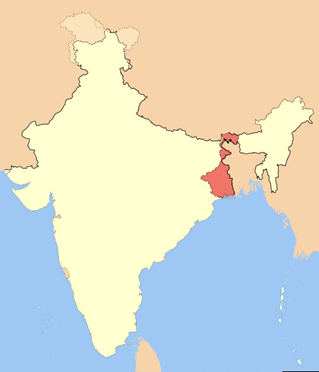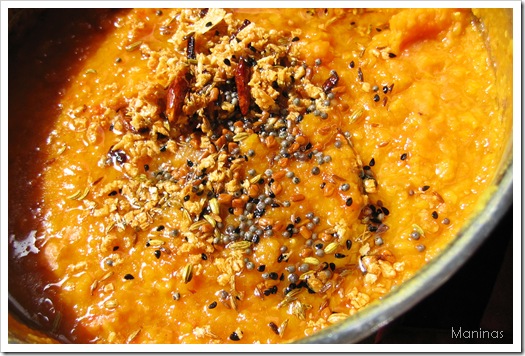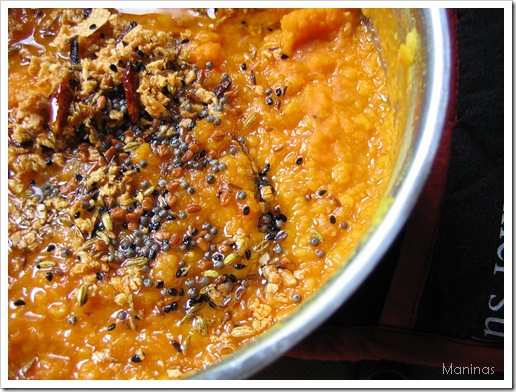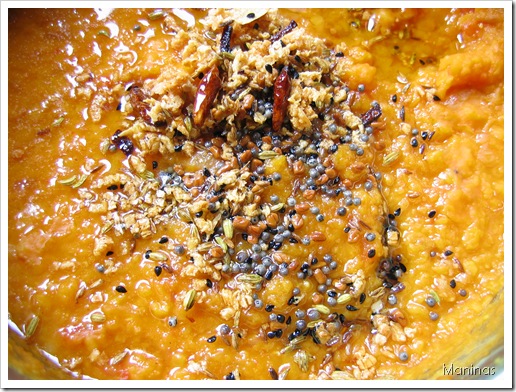
Hello! How are you, how’s the world at your end? Here in the UK, we’re cocooned in layers of snow of varying thickness, depending on where you are. When I was coming home tonight, around 6.30 pm, I felt this thick layer of snow under my feet is starting to freeze. I wonder what we’ll wake up to tomorrow. As idyllic as it all looks, us Mediterranean types are not faring to well in these conditions. All I want to do is hibernate until the sun shines back on us again. But though I refuse to believe it, the life goes on. There are jobs to do, people to see, dinners to cook… Yes… Dinners… Here’s what kept me awake and re-energised me this evening. Remember that delicious Sri Lankan dhal I was telling you about earlier? Here’s the recipe. Without the photos for now, until my camera awakes from its winter sleep. (I meant to take photos this evening, but my camera failed me.)

This dhal is a serious contender for the title of my favourite dhal, so far held by the seductive Bengali Red Dal. It has a rich gutsy flavour of red lentils cooked with onion, garlic, chillies, and cumin and black pepper, imbued with the heady aroma of curry leaves, and with a squeeze of lime to heighten your senses. I normally prefer to eat my dhal on the same day I make it, but this one I find improves with time. That is if you can stay away from it and leave some for tomorrow. I’m proud to day that this time I managed to do just that. Not even I can eat this much dhal at one sitting!
Let not the long list of ingredients intimidate you. This dhal is really very easy to make, and you can leave it to look after itself while you’re doing something else. Like making Sri Lankan coconut rotis, for example. Yes, that’s a good thing to do. (Recipe coming soon.)
________________________________________________
Sri Lankan coconut dhal
SOURCE: Jasmine’s recipe
PREPARATION TIME: under 5 min
COOKING TIME: about 45 min
CUISINE: Sri Lankan
SERVES: 3 – 4 as a side dish, or 2 as a main
INGREDIENTS:
1 cup of red lentils
1/4 red (medium to large) onions, or 2 shallots
2 large cloves of garlic, sliced
3 green chillies, roughly chopped
a handful of fresh curry leaves, shredded
1/3 tsp turmeric
2/3 tsp roughly ground cumin and black pepper mixture
1 scant tsp of fenugreek seeds
1/5 – 1/4 can of coconut milk
Juice of 1/2 lime, or more to taste
3 – 4 dried red chillies
salt to taste
a handful of (preferably fresh) curry leaves
1 tbsp vegetable oil or ghee
1 tbsp tempering spices (mixture of brown/black mustard seeds, cumin seeds and fennel seeds – see Sri Lankan spices for recipe)
1 1/2 tbsp fried onions (or 3 – 4 shallots, shredded and then fried as below)
METHOD:
Place the lentils in about 2 – 3 cups of water. Then chop the chillies, onions, garlic, shred the curry leaves and add them to the lentils, together with turmeric, fenugreek and the cumin and black pepper mixture. Boil together until the lentils turn soft.
When the lentils are soft, add the coconut milk and stir through.
Before you’re ready to eat, prepare the tadka or tempering for the dhal. I usually don’t have fried onions at hand, so this is what I do. I heat the oil and then add the chillies and the curry leaves to it. when the curry leaves are starting to turn crisp, I pop in the onions/shallots, and cook them until they’re almost copper brown. Then add a few more curry leaves (if you want, which I invariably do), and the tempering spices. Stir for 10 s or until they release their fragrance. Now pop the contents of the pan into the lentil mixture, reserving perhaps some for the garnish. Stir, put the lid back on, and leave it for a minute or two for the flavours to mingle and make friends.
Don’t forget the lime. I sometimes add it before adding the tadka to the lentils, and sometimes after the tadka. Either way, don’t leave it out. It really does make all the difference.
________________________________________________
More dhals from this blog:
Minty dhal (2 versions of recipe)
Also:
More recipes with beans and lentils
________________________________________________

We’re at the 8th helping of My Legume Love Affair hosted and organised by the talented Susan of The Well-Seasoned Cook. This is my entry for the event.
________________________________________________









